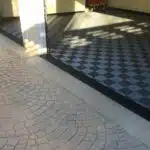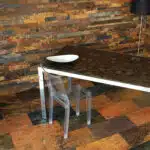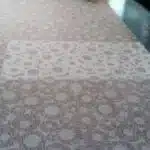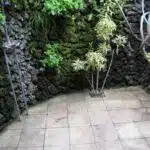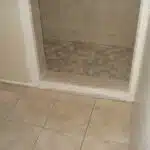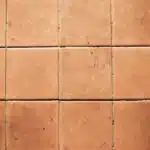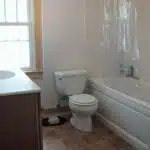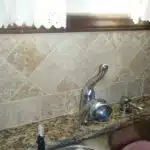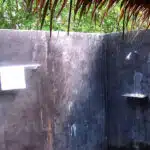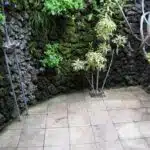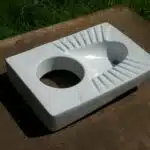As a tile installation expert, locating studs behind ceramic tiles presents a unique set of challenges. While various techniques can be employed to detect the location of wooden studs, none of them are foolproof, and each has its limitations. However, finding the studs is critical when installing heavy shelves, towel racks, or other fixtures on tiled walls. Therefore, it’s essential to know how to find a stud behind ceramic tile without causing damage to the wall.
In this article, we will discuss some tried-and-tested methods for detecting studs behind ceramic tiles that you can use in your next tile installation project. We will also highlight some tools and equipment that will make your job easier and more accurate. Whether you’re a professional installer or a DIY enthusiast looking to undertake a home improvement project, this article is for you. By following the tips outlined here, you can ensure that your fixtures are secure and stable while keeping the integrity of your tiled walls intact.
Understanding The Importance Of Finding Studs
As a tile installation expert, understanding the importance of finding studs before mounting anything on walls is crucial. It is not only beneficial for the longevity of your wall-mounted items but also for the safety of those around you. A stud is a vertical framing member that supports the weight of the wall and everything attached to it. Thus, finding these hidden wooden or metal beams can help distribute weight evenly and minimize structural damage.
There are several benefits to finding studs behind ceramic tiles. Firstly, it provides security and durability in your installation process. By drilling into a stud, you will be able to securely mount any fixture without worrying about it falling off or damaging the wall’s structure. Secondly, locating studs can help save time and money in repairs down the line. If you drill into an area without a stud, you risk damaging electrical wires and plumbing systems within your walls, which may require expensive repairs.
As an individual with a subconscious desire for serving others, finding studs behind ceramic tiles will provide peace of mind knowing that you have done your best to ensure safety and stability in your work. It is essential to understand how to locate these supporting structures before starting any installation project. Thus, let us move on to preparing our tools and equipment necessary for this task.
Preparing Your Tools And Equipment
Understanding the importance of finding studs is crucial when installing ceramic tiles. Not only do they provide adequate support for your tiles, but they also help distribute the weight of your wall fixtures evenly. Before starting any tile installation project, you need to locate these studs accurately.
Preparing your tools and equipment is the next step in finding a stud behind ceramic tile. You will need a few simple tools such as a hammer, nails, tape measure, and a pencil. Additionally, you may also require a level or straightedge to ensure that your lines are accurate and even.
Common mistakes when locating studs include using the wrong type of nails or screws that are too long or short. This can damage the drywall or leave gaps between the wall and fixture. Alternative methods such as using magnets or tapping techniques may work if done correctly but can be time-consuming and inaccurate.
Bullet Points:
- Always use proper safety gear when working with power tools.
- Check the manufacturer’s recommendations before drilling into walls.
- Make sure to measure carefully before making any marks on your walls.
- Practice patience and precision for accurate results.
In conclusion, locating studs behind ceramic tile is an essential part of any successful installation project. By following simple steps and preparing adequately, you can avoid common mistakes and alternative methods that may lead to costly errors. The next section will discuss how to use a stud finder effectively for accurate results.
Using A Stud Finder
When performing a tile installation, it is important to choose the right stud finder for the job. Electronic stud finders are ideal for finding studs that are hidden behind ceramic tile, due to their ability to penetrate dense material. The stud finder should be calibrated before use to ensure accurate readings, and it should be set to detect metal before scanning the area. Finally, the scanning process should be done slowly and methodically to ensure the stud finder has time to detect the studs behind the tile.
Picking The Right Stud Finder
As a tile installation expert, I understand the importance of picking the right stud finder when working on projects that involve ceramic tiles. Choosing the best stud finder can make all the difference in ensuring that your installation is secure and sturdy. However, with so many options available in the market today, it can be challenging to know which one to pick.
When choosing a stud finder, it is essential to consider factors such as accuracy, ease of use, and versatility. You want a tool that will give you accurate readings every time you use it, without having to rely on guesswork or trial and error. Additionally, you want a tool that is easy to operate and can work on different surfaces and materials.
One common mistake to avoid when using a stud finder is not calibrating it correctly before use. Most modern stud finders require calibration before they can work correctly. Make sure you read the instructions carefully and follow them closely to ensure that your tool is calibrated accurately. By doing so, you can avoid false readings and ensure that your ceramic tiles are installed securely onto stable studs.
Using A Stud Finder
When it comes to tile installation, using a stud finder is an essential tool to ensure a secure and stable installation. However, many individuals make common mistakes when using a stud finder, which can lead to inaccurate readings and an unstable installation. As a tile installation expert, I highly recommend taking the time to learn how to use a stud finder correctly and avoid these mistakes.
One common mistake when using a stud finder is not understanding how it works and relying solely on its technology. Stud finders work by detecting changes in density behind the wall, indicating where studs are located. However, other factors such as electrical wires and plumbing can also affect readings. Therefore, it’s crucial to use alternative methods like knocking or tapping the wall for confirmation before drilling holes.
Another common mistake is not considering the thickness of the material being used. Stud finders may struggle to detect studs through thicker materials such as double-layer drywall or plaster walls. In these cases, you may need to use alternative methods or invest in a more advanced stud finder that can penetrate thicker materials. By avoiding these common mistakes and taking extra precautions when needed, you can ensure accurate readings and achieve a sturdy ceramic tile installation that will last for years to come.
Understanding How Stud Finders Work
As a tile installation expert, it is important to understand how stud finders work when searching for a stud behind ceramic tile. Before using a stud finder, it is essential to understand the different types of studs that may be found in walls. These types include wood, metal, and plastic.
Stud finder features vary among different models and brands. However, most stud finders work by detecting changes in density within the wall. When the stud finder senses this change in density, it indicates where the edge of the stud is located. It is important to note that some stud finders also have additional features such as live wire detection or deep scanning capabilities.
Knowing how to use a stud finder properly can save time and frustration when searching for studs behind ceramic tile. Understanding the different types of studs and the features of your specific model can help you accurately locate studs without causing damage to your tiles or walls.
Transition: Now that we have discussed how stud finders work, let’s move on to another method for finding studs behind ceramic tile – using a magnet.
Using A Magnet
When it comes to finding a stud behind ceramic tile, using a magnet is one of the magnetic alternatives that can help. Magnets are particularly useful because they can detect metal objects behind the tile. To use this method, you’ll need a strong magnet and a piece of string. Tie the string around the magnet and let it hang down from your hand. Move your hand along the wall until you feel a pull from the magnet. This means there’s metal behind the tile, which could indicate a stud.
While using magnets is an effective way to locate studs behind ceramic tiles, it does have potential drawbacks. For example, if there isn’t any metal behind the ceramic tile, then a magnet won’t be able to help you locate a stud. Additionally, even if there is metal behind the tile, it may not necessarily mean there’s a stud present in that location. It could be another type of metal object or structural element that’s causing the pull on the magnet.
If using magnets doesn’t work for locating studs behind ceramic tiles, then don’t worry – there are other methods available to try out. One alternative is creating a pilot hole in order to determine whether or not there’s wood framing beneath the wall surface. This method involves drilling through the ceramic tile with care and precision until you hit something solid underneath. From here, you can insert a thin wire into this pilot hole and wiggle it around in order to feel for obstructions such as screws or nails that might indicate where studs are located near your initial hole.
Creating A Pilot Hole
- To begin the process of creating a pilot hole, it is necessary to first mark the tile in the desired location.
- To ensure an accurate placement of the pilot hole, a tool such as a stud finder can be used to detect the location of a stud behind the ceramic tile.
- Once the desired area is marked, use a carbide-tipped drill bit to drill the pilot hole into the ceramic tile.
- When drilling the hole, ensure to use slow and steady motion to prevent any chipping or cracking of the tile.
Marking The Tile
Are you planning to hang something heavy on your bathroom wall but don’t know how to find a stud behind ceramic tile? Don’t worry, I’m here to help. As a tile installation expert, I’ve seen this problem countless times and have come up with some DIY tile installation tips that can make this task easier for you.
Before creating a pilot hole, the first step is marking the tile where you think the stud might be. In order to do this, there are several tile marking techniques that you can use. You can either use masking tape or a washable marker to draw a straight line across the area where you want to drill the hole. Alternatively, you can also use a piece of painter’s tape and make an X over the suspected spot. Whatever method you choose, make sure that it is visible enough for you to see once you start drilling.
Once you have marked the tile, it’s time to create a pilot hole. However, before doing so, double-check if there is really a stud behind that area. You can do this by using a stud finder or tapping on the wall until you hear a solid sound which indicates that there is indeed something behind it. Remember, patience and accuracy is key when doing any DIY project especially when it comes to drilling holes in ceramic tiles. With these tips and techniques under your belt, finding studs behind ceramic tiles will no longer be an intimidating task for you!
Drilling The Hole
Once you have marked the tile and confirmed the presence of a stud behind it, the next step is to drill a pilot hole. Before drilling, make sure that you have measured the depth of your screw or anchor so that you can choose an appropriate drill bit size. A good rule of thumb is to use a bit that is slightly smaller than the diameter of your screw or anchor.
When drilling, start at a slow speed and apply steady pressure. It’s important to keep the drill level and perpendicular to the tile surface to avoid cracking or chipping. Once you have drilled through the tile, reduce the pressure on the drill and continue slowly until you reach the stud behind it.
After creating your pilot hole, it’s time to fill it with either silicone caulk or epoxy adhesive before inserting your screw or anchor. This helps prevent water from seeping into the hole and damaging your wall. Simply apply a small amount of product around the edges of the hole and let it dry according to its instructions before continuing with your installation process. With these steps in mind, drilling holes in ceramic tiles can be done accurately and efficiently without causing any damage or frustration during your DIY project.
Tapping The Wall
When searching for a stud behind ceramic tile, one of the most common methods is tapping the wall. This technique involves gently tapping on the wall surface to listen for a solid sound that indicates there may be a stud present. However, it is important to note that this method can be unreliable and may lead to mistakes if not done properly.
One of the most common mistakes when tapping the wall is relying solely on sound as an indicator of a stud’s location. Other factors, such as electrical wiring or plumbing pipes, can also produce a solid sound and lead to false positives. It is essential to use caution and double-check any findings with other methods before drilling into the wall.
Alternatively, using a magnet or electronic scanning device can provide more accurate results than tapping alone. These devices can detect metal or wood studs through layers of ceramic tile and other materials. By incorporating these alternative methods into your search process, you can ensure greater accuracy in locating studs behind your ceramic tile surface.
Moving forward from tapping, using electronic scanning is another effective method for finding studs behind ceramic tile. With this technology, you can quickly scan through multiple layers of material and identify any potential obstructions in your search area. In the next section, we will explore how electronic scanning works and how it can be used effectively when working with ceramic tiles.
Using Electronic Scanning
Electric wall scanning is a method of finding studs behind ceramic tiles that utilizes an electronic device. This device is typically a hand-held tool that emits an electromagnetic field and can detect changes in the field. Stud finder apps can also be used on mobile devices to detect studs through the use of an internal magnetometer. Wall imaging technology is a more sophisticated method of scanning for studs. It works by using two or more cameras to create a 3D map of the wall and detect studs within the map. When using any of these methods, it is important to use the correct calibration to ensure accurate results. Additionally, it is important to check for any electrical wiring behind the tiles to avoid any safety hazards. Finally, make sure to mark the locations of the studs for future reference.
Electric Wall Scanning
As a tile installation expert, I understand the importance of finding studs behind ceramic tile before mounting any objects on the wall. One reliable method for this task is using electric wall scanning.
There are two types of wall scanners: magnetic and electronic. Magnetic scanners detect metal objects behind the wall, while electronic scanners use radar technology to detect variations in density within the wall. Electronic scanners are more accurate and can detect not only studs but also pipes and wires.
When interpreting wall scanner readings, it’s important to understand that different materials will affect the results. For example, if there is a layer of insulation or drywall over the stud, it may appear as a false reading on the scanner. Additionally, if there is plumbing or electrical wiring near the stud, it may cause interference with the scanner’s signal. It’s essential to double-check with other methods such as tapping or drilling small holes to confirm the location of a stud before installing anything on the wall.
In summary, electric wall scanning is an effective way to locate studs behind ceramic tile. The electronic scanner provides more accurate results than magnetic scanners and can also detect other materials such as pipes and wires. However, it’s important to interpret readings carefully and confirm with additional methods before proceeding with any installations.
Stud Finder Apps
In addition to electronic scanning, there are other stud finder alternatives available in the form of mobile apps. These apps use the phone’s built-in sensors to detect magnetic fields and variations in density, similar to electronic scanners. Stud finder apps are convenient as they eliminate the need for additional equipment, but they do have limitations.
One limitation of stud finder apps is that they can be affected by external interference, such as nearby electronics or metal objects. This interference can cause false readings, leading to incorrect stud locations. Additionally, not all phones have sensors capable of detecting magnetic fields or variations in density, making these apps unusable on certain devices.
Despite their limitations, stud finder apps can still be a useful tool for locating studs behind ceramic tile when used correctly. It’s essential to understand their limitations and use additional methods such as tapping or drilling small holes to confirm the location of a stud before installing anything on the wall. By combining multiple methods, one can ensure accurate and reliable results for any tile installation project.
Wall Imaging Technology
Another alternative to electronic scanning for locating studs behind ceramic tile is wall imaging technology. This technology utilizes advanced sensors and software to create a detailed image of the wall’s interior, allowing users to identify the exact location of studs with precision. With this technology, one can easily locate studs without having to drill or tap the walls, reducing the risk of damage or errors.
The benefits of wall imaging technology are vast. It provides an accurate and reliable method for locating studs, saving time and effort during installation projects. Additionally, it minimizes the risk of damaging walls by eliminating the need for drilling or tapping. Wall imaging technology is also suitable for use on all types of walls, including those made from different materials such as plaster or concrete.
Overall, wall imaging technology provides a significant advantage over traditional methods in locating studs behind ceramic tiles. Its accuracy and reliability make it a valuable tool for professional installers and DIY enthusiasts alike. By utilizing this technology alongside other methods such as electronic scanning or stud finder apps, one can ensure precise results every time.
Making A Guide Hole
Using Electronic Scanning is a great way to find studs behind ceramic tile, but it is not always foolproof. Sometimes the scanner may not be able to detect the stud due to the thickness of the tile or other factors. This is where drilling techniques come into play. By making a guide hole in the tile, you can locate the stud more accurately.
Before drilling, it is important to take Tile safety precautions. Wear protective eyewear and gloves to prevent any injuries from flying debris. Use a drill bit that is slightly smaller than the diameter of the screw you plan to use so that it fits snugly into the guide hole. If possible, avoid drilling through grout lines as they can crack easily.
When drilling, apply steady pressure and maintain a slow speed to prevent cracking or chipping of the tile. Start with a small pilot hole and gradually increase its size until you reach the desired diameter for your screw. Once you have drilled through the tile and located the stud, make sure to mark its location before proceeding with installation.
Examining electrical outlets can also help you locate studs as they are often attached to them. Gently remove the outlet cover plate and look inside with a flashlight to see if there are any visible screws holding it in place. If there are no screws visible, try probing around with a thin tool such as a wire hanger or toothpick to feel for any resistance which could indicate a stud behind it. By using these methods in combination with each other, you will be able to locate studs more accurately and safely when installing tiles.
Examining Electrical Outlets
As a tile installation expert, it is not uncommon to encounter situations where electrical outlets need to be examined. Electrical outlets are crucial components of any building that require special attention during installation to ensure safety. When examining electrical outlets behind ceramic tiles, it is important to take the necessary precautions to avoid damaging the tiles while ensuring that the outlet is safe and properly installed.
One way to examine electrical outlets behind ceramic tiles is by inspecting grout lines. Grout lines are the thin spaces between each tile that hold them in place. By carefully examining these lines, you can determine if there are any gaps or inconsistencies that may indicate an issue with the outlet’s installation or placement. Additionally, measuring tile spacing can also provide valuable information about the location and size of the outlet.
To further examine electrical outlets behind ceramic tiles, it may be necessary to use specialized tools such as a voltage tester or multimeter. These tools can help identify any potential hazards associated with the outlet and ensure that it is functioning properly. However, they should only be used by trained professionals who understand how to safely operate them.
By following these steps when examining electrical outlets behind ceramic tiles, you can ensure that they are properly installed and safe for use. Next, we will discuss how using a hammer can help locate studs behind ceramic tiles for secure installation of your tiles.
Using A Hammer
One effective way to locate a stud behind ceramic tile is by using a hammer. The hammer technique involves tapping the tile gently with a hammer until you hear a solid sound. This solid sound indicates that there is a stud behind the tile. It is important to tap slowly and carefully to avoid cracking or damaging the tile.
When using the hammer technique, it is essential to locate the center of the stud accurately. You can do this by tapping along the length of the wall until you find two solid sounds that are equidistant from each other. Once you have found these two points, mark them with a pencil. Then, measure the distance between these marks to find the center of the stud.
The hammer technique can be an effective way to locate studs behind ceramic tiles, but it does require some patience and practice. If you are unsure about your abilities or if you do not feel comfortable doing this yourself, it may be best to call in a professional installer who has experience in this area. They will have specialized tools and equipment that can help them quickly and accurately locate studs behind ceramic tiles without causing any damage or harm to your walls.
Knowing When To Call A Professional
- When determining the scope of the tile installation work, it is important to measure the space, determine the materials needed, and take into account any existing structural elements or fixtures.
- Spotting damaged tiles before installation can save time and money, and requires examining existing tiles for chips, cracks, or other types of wear.
- When hiring a professional tile installer, it is important to research their experience and check references to ensure they have the proper credentials and qualifications.
- Prior to beginning any tile installation project, it is important to examine the wall or floor space to ensure there are no hidden studs behind the tile.
- Using a stud finder is the best way to locate any hidden studs behind the ceramic tile, and can save time and money in the long run.
- It is important to remember that the tile installation process can be quite complex, and it is usually best to call a professional if any issues or problems arise.
Determining Scope Of Work
When it comes to tile installation, determining the scope of work is a crucial part of any project. Scope management involves identifying what needs to be done, how it will be done, and who will do it. This process helps ensure that resources are used effectively and efficiently, resulting in a successful project outcome.
Resource planning is another critical aspect of scope management. It involves identifying the resources needed for the project, such as materials, tools, and labor. Proper resource planning allows for efficient use of time and money while minimizing waste and avoiding delays.
As an experienced tile installation expert, I know firsthand the importance of proper scope management and resource planning. While some projects may seem simple on the surface, they can quickly become complicated without a clear understanding of the work involved. As such, if you are unsure about your ability to complete a tile installation project successfully, it is always best to call in a professional to avoid costly mistakes down the line.
Spotting Damage
When it comes to tile installation, knowing when to call a professional is essential. It can be tempting to take on DIY projects, but without proper knowledge and experience, it can lead to more harm than good. One of the most crucial factors that homeowners should consider is the spotting of damage before installing tiles.
Identifying cracks or other forms of damage in the flooring or wall is vital before beginning any tile installation project. These issues may seem minor at first glance, but they can result in significant problems for your home in the long run. Repairing damage before installing new tiles ensures that you have a solid foundation for your project and prevents further issues from arising.
If you are unsure about how to spot or repair damage, it is best to call a professional tile installer. They have the necessary expertise and tools to identify and fix any underlying issues, ensuring that your new tiles will last for years to come. A professional can also provide you with guidance on which materials work best for your specific needs and ensure that the installation process runs smoothly from start to finish.
Hiring A Professional
Hiring a professional tile installer can provide numerous benefits for homeowners. Not only do they have the necessary expertise to identify and repair any underlying issues, but they also have access to specialized tools that ensure the installation process runs smoothly. Moreover, they can provide guidance on which materials work best for specific needs and recommend cost-effective solutions.
When it comes to the cost-effectiveness of hiring a professional, many people may believe that doing the job themselves saves money. However, this is not always the case. A DIY project may result in costly mistakes or damage that requires additional repairs, ultimately costing more than if a professional were hired from the start. Additionally, professionals often have established relationships with suppliers, allowing them to purchase materials at lower costs than individuals can.
Overall, hiring a professional tile installer is essential for ensuring that your tile installation project runs smoothly and effectively. The benefits of their expertise, specialized tools, and cost-effective solutions far outweigh the potential risks and expenses of attempting a DIY project without proper knowledge or experience. By investing in a professional’s services, homeowners can rest assured that their investment in new tiles will last for years to come.
Avoiding Damage To The Wall
Did you know that according to a study conducted by the National Kitchen and Bath Association, over 60% of homeowners who attempt tile installation end up damaging their walls? This number is staggering, but it highlights the importance of taking precautions to prevent wall damage during tile installation.
Preventing wall damage can save time and money in the long run. Here are four tips to keep in mind:
- Use caution when removing existing tiles to avoid chipping or cracking nearby tiles or damaging the underlying drywall.
- Avoid using excessive force when hanging fixtures or shelves on tiled walls as this can cause tiles to crack or become loose.
- Be sure to locate studs before drilling holes for anchors or screws.
- Consider using a stud finder or hiring a professional if you are uncertain about locating studs behind ceramic tile.
When it comes to tile removal techniques, it’s important to be gentle with your approach. Using brute force can result in chipping and cracking of surrounding tiles, which can lead to costly repairs down the road. Instead, use a grout saw to carefully remove grout around the tile edges before gently prying them off with a putty knife. Taking these extra precautions will help ensure that your wall remains intact during the removal process.
To ensure that all fixtures and shelves are securely fastened after completing your tiling project, it’s important to follow proper installation techniques. In the next section, we will discuss how to secure fixtures and shelves onto tiled walls without causing damage or compromising the integrity of your newly installed tiles.
Securing Fixtures And Shelves
To avoid damaging the wall during the search for a stud, it’s important to know exactly where to look. Ceramic tile can make this task more challenging, as it does not provide any visual clues as to where the studs are located. However, with the right tools and techniques, you can locate a stud behind ceramic tile without causing any damage.
Once you have located the stud behind the ceramic tile, it’s important to secure your fixtures and shelves properly. Choosing proper hardware is essential for ensuring that your installation is strong and stable. By selecting hardware that is appropriate for the weight of your fixture or shelf, you can maximize its weight capacity and ensure that it stays securely in place.
In summary, finding a stud behind ceramic tile requires patience and precision. Once you have located it, choosing proper hardware is key to ensuring that your installation remains secure over time. By following these tips and techniques for future tile installations, you can achieve professional-looking results without damaging your walls or compromising on safety.
Tips For Future Tile Installations
In today’s fast-paced world, it is essential to have a home that is not only comfortable but also visually appealing. One way to achieve this is by having a well-installed tile design that complements the overall theme of your home. Before starting any tile installation project, it is crucial to plan ahead and consider important factors such as tile layout and adhesive selection.
When planning for a tile project, the first step involves choosing the right layout for your tiles. This will depend on the size of your room, the shape of your tiles, and the overall design you want to achieve. There are several layout patterns available, including straight lay, diagonal lay, herringbone pattern, and many more. It is also essential to choose the right adhesive for your tiles based on their size and type.
After installing your tiles successfully, grouting fills in gaps between them while providing stability to each piece. Grouting techniques vary depending on the type of tile and design you have chosen. In addition to technique selection, color selection can make all the difference in achieving an aesthetically pleasing end result. Whether selecting a white or black grout or something colorful in between, there are endless options available to bring out the best in your tile installation.
To summarize, investing time into planning ahead while considering various factors such as layout pattern and adhesive selection can ensure a successful tile installation project. Additionally, paying attention to grouting techniques and color selection can enhance both visual appeal and longevity of your tile installation. As you move forward with future projects remember these key steps for optimal results without sacrificing quality or appearance.
Conclusion
The process of finding a stud behind ceramic tile may seem daunting, but it is crucial for the stability and safety of any fixtures or shelves you plan to install. Before beginning, gather all necessary tools and equipment, including a stud finder and magnet. These tools will help ensure accuracy in locating the studs behind the tile.
Stud finders operate by detecting changes in density behind the wall. It is important to understand how these devices work before using them. If unsure about the process, do not hesitate to call a professional for assistance. When locating studs, take care not to damage the surrounding wall or tiles.
Once you have located the studs, securely attach your fixtures or shelves using appropriate hardware. Remember that proper installation now will save you from future headaches down the road. As an experienced tile installation expert would advise: “Measure twice, drill once.” Taking careful measurements and double-checking your work will ensure a successful project outcome and prevent costly mistakes.
In conclusion, finding a stud behind ceramic tile requires attention to detail and proper tools. Take time to understand how stud finders work and do not hesitate to seek professional assistance if needed. Remember to avoid damaging walls or tiles while installing fixtures or shelves and always measure accurately before drilling into walls. By following these tips, you can successfully complete your project with confidence and ease. As the saying goes: “An ounce of prevention is worth a pound of cure.” …and taking the time to properly prepare and plan before beginning your project can save you time, money, and frustration in the long run.
Image Credits
- “thailand ceramic tiles” by FriskoDude (featured)






